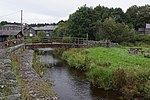Llyn Alwen
Clwyd geography stubsLakes of Conwy County BoroughRally GB

Llyn Alwen is a small natural upland lake on Mynydd Hiraethog in Conwy County Borough, Wales at SH 898 565. It lies on the rolling Silurian moorland to the north-west of Mwdwl-eithin and about 10 km to the east of Betws y Coed. The discharge from the lake flows under the A543 road to form the headwater of Alwen Reservoir. The area was used as a special stage during the 2015 Wales Rally GB.
Excerpt from the Wikipedia article Llyn Alwen (License: CC BY-SA 3.0, Authors, Images).Llyn Alwen
Other Route of Public Access,
Geographical coordinates (GPS) Address Nearby Places Show on map
Geographical coordinates (GPS)
| Latitude | Longitude |
|---|---|
| N 53.0947 ° | E -3.6474 ° |
Address
Other Route of Public Access
Other Route of Public Access
LL24 0TA , Pentrefoelas
Wales, United Kingdom
Open on Google Maps











